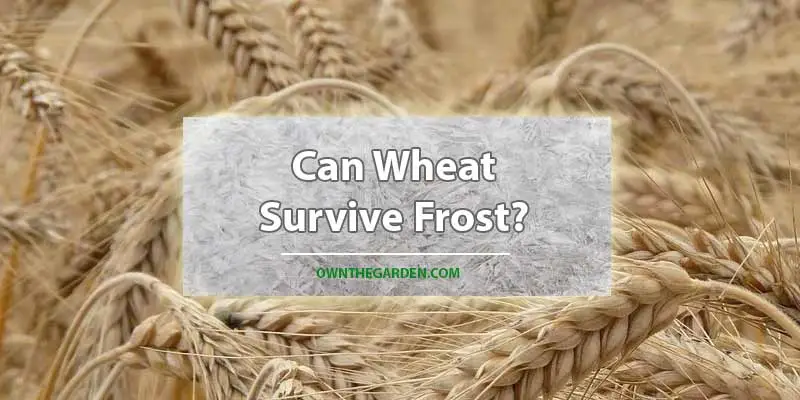Winter is coming, and that means you’ll have to protect your wheat from frost. Fortunately for growers everywhere, this is not a difficult task. In fact, there are many ways to keep your precious grains safe over the winter months!
Can Wheat Survive Frost?
Wheat can survive frost, but it might not be as productive as a wheat crop that was not exposed to frost. Frost can kill the wheat’s growth and development, and it will prevent the grain from ripening properly. It also makes the wheat more susceptible to disease and pests.
If your wheat is already showing signs of frost damage, such as browning or yellowing leaves and stunted growth, then you should harvest it immediately. However, if you still have green leaves and healthy-looking stems, then your wheat may recover from the frost damage without any problems at all.
How Tolerant Is Wheat To Cold Weather
Wheat is a crop that can take the heat and humidity of the South, but when it comes to cold weather, it’s not as tolerant. The average temperature for wheat growing regions is around 70 degrees Fahrenheit. However, there are some varieties of wheat that tolerate temperatures as low as 20 degrees Fahrenheit.
In order to determine how cold-hardy your variety of wheat is, you need to know what category it falls into, which is winter or spring wheat. Most varieties of winter wheat are considered hardy because they are planted in the fall and mature in the spring. They have been bred to withstand colder temperatures than their spring counterparts.
How To Protect Your Wheat From Frost
There are a few ways to protect your wheat from freezing temperatures:
Cover plants with a blanket or plastic sheet. This is the easiest but most temporary option, as it’s only effective while the temperature remains above 32 degrees Fahrenheit (0 Celsius). If you’re using this method, make sure to remove the cover once your crop has grown enough so that its leaves will be able to block out sunlight from the tops of its stalks.
Keep plants growing in the greenhouse or indoors. The best way to do this is by keeping them in pots or trays so you can bring them inside whenever frost starts threatening your crops outside. You’ll also want to keep them watered frequently and make sure there’s enough light for them—if you’re not sure whether they have enough light, use an artificial source like fluorescent lights instead of natural sunlight until spring comes around again!
Caring For Wheat During The Winter
If you’re planning to grow wheat throughout the winter, you’ll need to care for it. Below are some of what you will need to do to ensure the wheat will survive the cold.
Watering: If your wheat hasn’t been watered in a while, do it now. The plants need moisture to grow and thrive. If the ground is covered with snow already, you will not need to water them. On the other hand, if there is no snow yet and the ground is dried, give it a light watering.
Fertilizing: If you’re going to be out of town or unable to water your crop, consider fertilizing it with manure or compost (both are cheap options). This will help ensure that the plant gets the nutrients it needs before winter hits and makes sure it has enough energy stored up for springtime growth when there will be little natural food available.
Pest Control: Another way to help maximize your wheat crop’s chances of survival is by spraying some pesticide on any bugs lurking around your fields this time of year. Some people recommend using an organic insecticide such as pyrethrin, but others say this kind of treatment isn’t necessary because most pests won’t survive through freezing temperatures anyway—and even if they do manage a few days above freezing, those days won’t be enough for them to do much damage anyway.
It’s generally recommended not to use chemical pesticides unless absolutely necessary due to their potential negative impact on human health over time as well as their lack of effectiveness at killing pest species without killing other beneficial insects nearby too; however, if all else fails then these might work better than nothing at all!
What Temperatures Will Kill Wheat?
Unfortunately, even the hardiest of varieties will succumb to frost.
Frost damage can be a result of temperature or duration, but it’s usually both. For example, if you experience a light frost that lasts for a few minutes at 20°F (–6°C), your wheat might not suffer any ill effects. However, if temperatures drop below freezing for more than two hours and reach 30°F (–1°C) or lower during that time frame, your crop will likely die.
Can I overwinter Wheat?
It’s possible to overwinter wheat, but it can be tricky. There are some key things you need to do in order for your wheat to survive the harsh winter months.
- You’ll need a greenhouse or other sheltered structure that is large enough to house your plants.
- Make sure everything is insulated well so the inside of the structure stays warm and there isn’t any dead air space where cold winds can get in.
- Set up fans or heaters as necessary, depending on what kind of climate zone you live in and how cold it gets at night outside your structure (if there is no natural protection from winds).
- Water regularly during dry spells (especially if rain isn’t able to reach them).
Conclusion
If you want to grow wheat, it is important that you know how to protect it from frost. Wheat can survive light frosts, but heavy frosts that occur during pollination will cause the plants to die.


